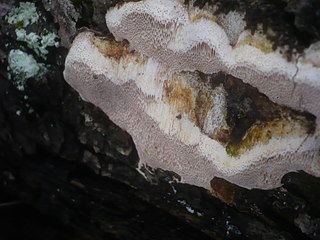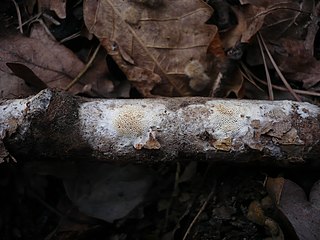
Perenniporia is a cosmopolitan genus of bracket-forming or crust-like polypores in the family Polyporaceae. They are dimitic or trimitic with smooth, thick-walled basidiospores and cause a white rot in affected wood.

Rigidoporus is a genus of fungi in the family Meripilaceae. Many of the species in this genus are plant pathogens. The widespread genus, which contains about forty species, was originally circumscribed by American mycologist William Alphonso Murrill in 1905. The generic name combines the Latin word rigidus ("rigid") with the Ancient Greek word πόρος ("pore").

Ceriporiopsis is a genus of fungi in the family Phanerochaetaceae. The genus is widely distributed, and, according to a 2008 estimate, contains about 25 species. Ceriporiopsis was circumscribed in 1963 by Polish mycologist Stanislaw Domanski. The genus is a wastebasket taxon, containing "species that share common macroscopic and microscopic characteristics, but are not necessarily related." Ceriporiopsis species are crust fungi that cause a white rot. They have a monomitic hyphal system, containing only generative hyphae, and these hyphae have clamp connections.

Ceriporia is a widely distributed genus of crust fungi.

Antrodiella is a genus of fungi in the family Steccherinaceae of the order Polyporales.

Amauroderma is a genus of polypore fungi in the family Ganodermataceae. The genus, widespread in tropical areas, contains about 70 species. Amauroderma fungi are wood-decay fungi that feed and fruit on decayed branches and trunks.

Dichomitus is a genus of poroid crust fungi in the family Polyporaceae. It was circumscribed by English mycologist Derek Reid in 1965.

Diplomitoporus is a genus of fungi in the family Polyporaceae. The Dictionary of the Fungi estimated the widespread genus to contain 11 species; since then, the genus has grown with the additional of several newly described species, and some transfers from other genera. Diplomitoporus has been described as a wastebasket taxon, containing "species that share common macroscopic and microscopic characteristics, but are not necessarily related."
Navisporus is a genus of seven species of tropical poroid fungi in the family Polyporaceae. It was circumscribed by Norwegian mycologist Leif Ryvarden in 1980 with Navisporus floccosus as the type species. This fungus, first described as Trametes floccosa by Giacomo Bresadola in 1896, is thought to have been originally collected in Tanzania.
Amauroderma albostipitatum is a polypore fungus in the family Ganodermataceae. It was described as a new species in 2015 by mycologists Allyne Christina Gomes-Silva, Leif Ryvarden, and Tatiana Gibertoni. The specific epithet albostipitatum refers to the characteristic whitish stipe. A. albostipitatum is found in the states of Rondônia and Roraima, in the Brazilian Amazon. It fruits on soil.
Amauroderma aurantiacum is a polypore fungus in the family Ganodermataceae. It was first described as a species of Ganoderma by Portuguese botanist Camille Torrend in 1932. Tatiana Gibertoni and Annarosa Bernicchia transferred it to Amauroderma in 2008. A. aurantiacum is found in Brazil and Venezuela.
Amauroderma calcigenum is a polypore fungus in the family Ganodermataceae. It was first described as a species of Polyporus by Miles Joseph Berkeley in 1843. Camille Torrend transferred it to genus Amauroderma in 1920. A. calcigenum is found in Brazil, Guyana, and Venezuela.
Amauroderma floriformum is a polypore fungus in the family Ganodermataceae. It was described as a new species in 2015 by mycologists Allyne Christina Gomes-Silva, Leif Ryvarden, and Tatiana Gibertoni. The specific epithet floriformum refers to the flower-shaped fruit body. A. floriformum is found in the state of Pará, in the Brazilian Amazon.
Amauroderma laccatostiptatum is a polypore fungus in the family Ganodermataceae. It was described as a new species in 2015 by mycologists Allyne Christina Gomes-Silva, Leif Ryvarden, and Tatiana Gibertoni. The specific epithet laccatostiptatum refers to the varnished stipe. A. laccatostiptatum is found in the states of Amazonas, Pará, and Rondônia in the Brazilian Amazon. The fungus fruits on soil.
Amauroderma ovisporum is a polypore fungus in the family Ganodermataceae. It was described as a new species in 2015 by mycologists Allyne Christina Gomes-Silva, Leif Ryvarden, and Tatiana Gibertoni. The specific epithet ovisporum refers to the ovoid shape of the basidiospores. A. ovisporum is found in the states of Pará and Rondônia in the Brazilian Amazon.
Amauroderma sessile is a polypore fungus in the family Ganodermataceae. It was described as a new species in 2015 by mycologists Allyne Christina Gomes-Silva, Leif Ryvarden, and Tatiana Gibertoni. The specific epithet sessile refers to the characteristic stipe-free fruit body. A. sessile is found in the states of Amazonas, Mato Grosso, and Pará in the Brazilian Amazon.
Amauroderma subsessile is a polypore fungus in the family Ganodermataceae. It was described as a new species in 2015 by mycologists Allyne Christina Gomes-Silva, Leif Ryvarden, and Tatiana Gibertoni. The specific epithet subsessile refers to "the basidiomata not completely sessile, with a short to long stipe". A. subsessile is found in the states of Rondônia and Pará in the Brazilian Amazon, as well as Costa Rica and Panama.
Nigroporus macroporus is a species of poroid fungus in the family Steccherinaceae. It was described as new to science in 2003 by mycologists Leif Ryvarden and Teresa Iturriaga. Found in Venezuela and Brazil, it is a wood-decay fungus that causes a white rot in the hardwood Dimorphandra macrostachya.
Ceriporia amazonica is a species of crust fungus in the family Irpicaceae. Found in Brazil, it was described as new to science in 2014. The fungus is characterized by its salmon-coloured pore surface with angular pores numbering 1–3 per millimetre, and small ellipsoid spores that are among the smallest in genus Ceriporia. The type locality is Amapá National Forest, in the Brazilian Amazon, for which the species is named.
Datroniella minuta is a species of fungus in the family Polyporaceae. It was described in 2016 by mycologists Carla Rejane Sousa de Lira and Leif Ryvarden from collections made in northeast Brazil. The fungus is characterized by its tiny, cup-shaped fruit bodies that are reddish to dark brown, and microscopically by its large cylindrical spores that typically measure 9–10 by 3 µm.








